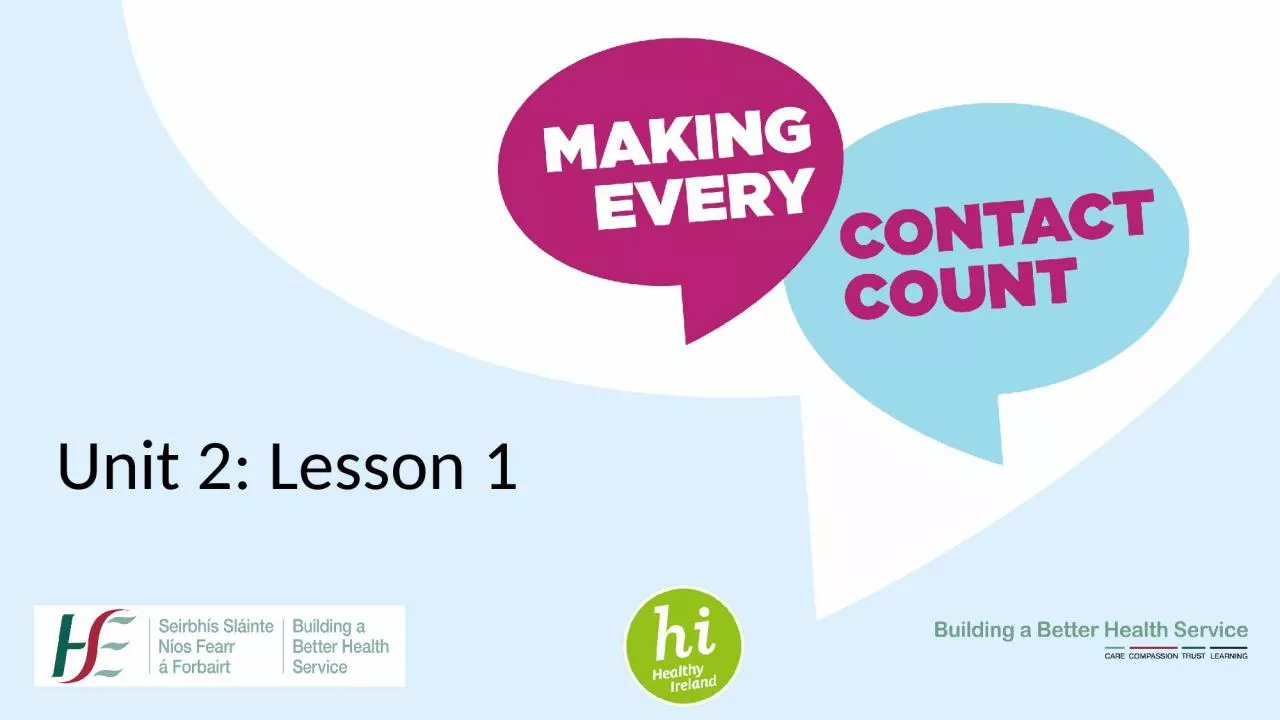

Lesson 1 Health Behaviour Making Every Contact Count Play your part in changing lifestyle behaviours and help prevent chronic disease RECAP UNIT 1 T he conceptdefinition of health amp personal wellness ID: 935253
Download Presentation The PPT/PDF document "Unit 2: Lesson 1 Lifestyle Behaviours ..." is the property of its rightful owner. Permission is granted to download and print the materials on this web site for personal, non-commercial use only, and to display it on your personal computer provided you do not modify the materials and that you retain all copyright notices contained in the materials. By downloading content from our website, you accept the terms of this agreement.
Slide1
Unit 2: Lesson 1
Slide2Lifestyle Behaviours and Personal Responsibility for Health
Lesson 1: Health Behaviour
Slide3Making Every Contact Count
Play your part
in changing lifestyle behaviours
and help prevent chronic disease
Slide4RECAP UNIT 1
The concept/definition of health& personal wellness
The Biopsychosocial Model of HealthFour lifestyle areas critical to chronic disease prevention
- Diet, Exercise, Tobacco use and Alcohol
Slide5What is Health Behaviour?
• Health behaviours are activities undertaken by a patient believing him/herself to be healthy for the purpose of preventing disease or detecting it at an asymptomatic stage (Kasl & Cobb, 1966).
• “…any activity undertaken for the purpose of preventing or detecting disease or for improving health and well-being” (Norman & Conner, 1996).
Slide6Health Behaviours
Vs Health
Outcomes
Aiming to eat 3 pieces of fruit a day
Reducing blood pressure
Having
the confidence to ride a bike
Losing weight
Walking in the park
Drinking non-alcoholic beer on a night out
Reducing cholesterol Speaking with a louder voice Walking to work instead of driving
Which of the following are health behaviours?
Slide7What behaviour do you do routinely, to prevent yourself getting ill, and to maintain or promote good health
? List these behaviours in the categories below:
Behaviour which prevents ill health (e.g. taking daily vitamins) …………………………………………………………………………………….
Behaviour
which promotes good
health (e.g
. taking regular exercise
)…………………………………………………………………………..
Behaviour
which sustains good
health (e.g
. brushing/flossing teeth three times a day
)………………………………………………..
Now
make a list of some of your behaviour that you would consider to be “unhealthy
” ……………………………………………..
(e.g
. smoking; not getting enough leisure or relaxation)Do you hold any inconsistent behaviours?(e.g. eating a healthy, calorie controlled diet but not taking any exercise) ……………………………………………………………………………………………………………………………………………………………………………………..6. Which behaviour has changed over time, and why (e.g. did you smoke when you were a teenager, or drink more alcohol
than you do now? Have you recently started exercising regularly?) ……………………………………………………………………………..6.1. Reason for change?................................................................................................................................................
Activity 2.1
Personal Health Behaviour Questionnaire
Slide8Who/What
influences our
health behaviour?
Slide9Health behaviour: Cause & Effect
? ~ 75
% of all cancer deaths are related to lifestyle behaviour
Lifestyle
Behaviour
Cancer
Deaths
Smoking
30%
Alcohol
3%
Diet
35%
Reproductive/sexual behaviour
7%
Doll and Peto (1981)
Does this information surprise you
?
What
other factors
could
be responsible for poor health?
Slide10Lifestyle factors predicting mortality
Slide11Social influences on health/health behaviour
Alameda County Study (1965)
Social and economic disadvantage
Slide12Health Determinants
Dahlgren-Whitehead Model (1991)
Slide13Determinants of Health
Non-modifiable
AgeSex Genetics
Modifiable
Personal lifestyle and behaviours
Social support
Community networks
Living and working conditions
Access to facilities and services
Economic, cultural and environmental conditions
Slide14How might this model be relevant/applicable to patients with chronic disease?
Slide15Why treat people’s illness without changing what makes them sick in the first place?